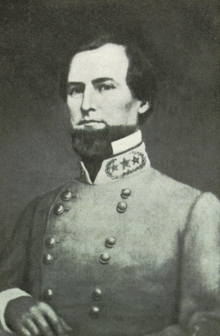North Carolina's 4th congressional district
| North Carolina's 4th congressional district | |
|---|---|
|
North Carolina's 4th congressional district - since January 3, 2013. | |
| Current Representative | David Price (D) |
| Distribution |
|
| Population (2014) | 795,798 |
| Ethnicity | |
| Occupation |
|
| Cook PVI | D+17[2] |
The Fourth Congressional district of North Carolina is located in the central region of the state. The district stretches from Burlington to Fayetteville. It includes two-thirds of the state capital, Raleigh, all of Chapel Hill, Carrboro, and Hillsborough, and portions of Durham.
The district is currently represented by 11-term Congressman David Price, a former political science professor at Duke who was first elected in 1986, ousting one-term Republican incumbent Bill Cobey.[3] Price was reelected in 1988, 1990, and 1992, but he was defeated in his bid for a fifth term in 1994 by Republican Fred Heineman, the Raleigh Police Chief, in a generally bad year for Democrats in North Carolina. Price came back to defeat Heineman in a rematch in 1996, and has been reelected each time since then by large margins, usually with more than 60% of the vote. In 2008, Price received 63% (265,751 votes) to defeat Republican challenger B.J. Lawson, who received 37% (153,947 votes).[4]
According to research by Christopher Ingraham of the Washington Post, the district is the third most gerrymandered Congressional district in North Carolina and seventh most gerrymandered district in the United States.[5] In contrast, its predecessor was the most regularly drawn of the state's 13 districts.
History
From 2003 to 2013 it contained most of the area commonly known as The Triangle. It included all of Durham and Orange counties, part of Wake County and a small section of Chatham County. The 4th district picked up the most Republican areas of Wake County, such as Apex, Cary, and much of North Raleigh in order to help make the neighboring 13th and 2nd districts more Democratic. For instance, Barack Obama defeated John McCain in the Wake County portion of the district in 2008 by 51–48%, a difference of less than 8,000 votes in between the two candidates.[6] In contrast, Obama won Wake County overall by a much greater margin of 56–43%, and Obama swept the 4th district as a whole by 63–36%. The Republican influence in the district's Wake County portion was more than canceled out by the two Democratic strongholds of Orange and Durham counties, where Obama received 72% and 76%, respectively, his two best counties in the entire state. The 4th district had a Cook PVI of D+8, which made it the most Democratic white-majority district in the entire South outside of South Florida and Northern Virginia.
The district became even more heavily Democratic as a result of 2012 redistricting, in which the more Republican areas of western and southern Wake County were removed, along with northern Orange County and most of its share of Durham County. They were replaced by heavily Democratic portions of Alamance, Cumberland, Harnett and Lee counties. Additionally, the district was pushed further into Raleigh. Like its predecessor, the district is one of the few Southern districts with a significant concentration of progressive-minded white voters—similar to areas around Atlanta, Houston, Charlotte, Nashville, Memphis and Austin. The presence of the University of North Carolina-Chapel Hill and Duke University, as well as a large African-American population in Durham and Raleigh help contribute to the liberal nature of the 4th district.
The district is just barely contiguous; the northern and southern portions are connected by a barely-discernible strip of land along the Lee/Harnett line.
Voting
| Election results from presidential races | ||
|---|---|---|
| Year | Office | Results |
| 2012 | President | Obama 71–28% |
| 2008 | President | Obama 72–27% |
| 2004 | President | Kerry 61–38% |
List of representatives
| Representative | Party | Years | District Residence | Note | |
|---|---|---|---|---|---|
 John Steele John Steele |
Pro-Administration | April 19, 1790 – March 3, 1791 | Redistricted to the 1st district | ||
 Hugh Williamson Hugh Williamson |
Anti-Administration | March 4, 1791 – March 3, 1793 | Redistricted from the 2nd district | ||
 Alexander Mebane Alexander Mebane |
Anti-Administration | March 4, 1793 – March 3, 1795 | |||
 Absalom Tatom Absalom Tatom |
Democratic-Republican | March 4, 1795 – June 1, 1796 | Resigned | ||
 William F. Strudwick William F. Strudwick |
Federalist | November 28, 1796 – March 3, 1797 | |||
 Richard Stanford Richard Stanford |
Democratic-Republican | March 4, 1797 – March 3, 1803 | Redistricted to the 8th district | ||
 William Blackledge William Blackledge |
Democratic-Republican | March 4, 1803 – March 3, 1809 | |||
 John Stanly John Stanly |
Federalist | March 4, 1809 – March 3, 1811 | |||
 William Blackledge William Blackledge |
Democratic-Republican | March 4, 1811 – March 3, 1813 | |||
 William Gaston William Gaston |
Federalist | March 4, 1813 – March 3, 1817 | |||
 Jesse Slocumb Jesse Slocumb |
Federalist | March 4, 1817 – December 20, 1820 | Died | ||
 William S. Blackledge William S. Blackledge |
Democratic-Republican | February 7, 1821 – March 3, 1823 | |||
 Richard D. Spaight, Jr. Richard D. Spaight, Jr. |
Crawford D-R | March 4, 1823 – March 3, 1825 | |||
 John Heritage Bryan John Heritage Bryan |
Jacksonian | March 4, 1825 – March 3, 1827 | |||
| Adams | March 4, 1827 – March 3, 1829 | ||||
 Jesse Speight Jesse Speight |
Jacksonian | March 4, 1829– March 3, 1837 | |||
 Charles B. Shepard Charles B. Shepard |
Whig | March 4, 1837 – March 3, 1839 | |||
| Democratic | March 4, 1839 – March 3, 1841 | ||||
 William H. Washington William H. Washington |
Whig | March 4, 1841 – March 3, 1843 | |||
 Edmund Deberry Edmund Deberry |
Whig | March 4, 1843 – March 3, 1845 | Redistricted from the 7th district | ||
 Alfred Dockery Alfred Dockery |
Whig | March 4, 1845 – March 3, 1847 | |||
 Augustine H. Shepperd Augustine H. Shepperd |
Whig | March 4, 1847 – March 3, 1851 | |||
 James T. Morehead James T. Morehead |
Whig | March 4, 1851 – March 3, 1853 | |||
 Sion H. Rogers Sion H. Rogers |
Whig | March 4, 1853 – March 3, 1855 | |||
 Lawrence O'Bryan Branch Lawrence O'Bryan Branch |
Democratic | March 4, 1855 – March 3, 1861 | |||
| Civil War and Reconstruction | |||||
 John T. Deweese John T. Deweese |
Republican | July 6, 1868 – February 28, 1870 | Resigned | ||
 John Manning, Jr. John Manning, Jr. |
Democratic | December 7, 1870 – March 3, 1871 | |||
 Sion H. Rogers Sion H. Rogers |
Democratic | March 4, 1871 – March 3, 1873 | |||
 William A. Smith William A. Smith |
Republican | March 4, 1873 – March 3, 1875 | |||
 Joseph J. Davis Joseph J. Davis |
Democratic | March 4, 1875 – March 3, 1881 | |||
 William R. Cox William R. Cox |
Democratic | March 4, 1881 – March 3, 1887 | |||
 John Nichols John Nichols |
Independent | March 4, 1887 – March 3, 1889 | |||
 Benjamin H. Bunn Benjamin H. Bunn |
Democratic | March 4, 1889 – March 3, 1895 | |||
 William F. Strowd William F. Strowd |
Populist | March 4, 1895 – March 3, 1899 | |||
 John W. Atwater John W. Atwater |
Independent Populist | March 4, 1899 – March 3, 1901 | |||
 Edward W. Pou Edward W. Pou |
Democratic | March 4, 1901 – April 1, 1934 | Died | ||
 Harold D. Cooley Harold D. Cooley |
Democratic | July 7, 1934 – December 30, 1966 | Resigned | ||
 James C. Gardner James C. Gardner |
Republican | January 3, 1967 – January 3, 1969 | |||
 Nick Galifianakis Nick Galifianakis |
Democratic | January 3, 1969 – January 3, 1973 | Redistricted from the 5th district | ||
 Ike F. Andrews Ike F. Andrews |
Democratic | January 3, 1973 – January 3, 1985 | |||
 Bill Cobey Bill Cobey |
Republican | January 3, 1985 – January 3, 1987 | |||
| |
Democratic | January 3, 1987 – January 3, 1995 | |||
 Fred Heineman Fred Heineman |
Republican | January 3, 1995 – January 3, 1997 | |||
| |
Democratic | January 3, 1997 – Present | |||
Historical district boundaries

See also
References
- ↑ United States Census Bureau. "My Congressional District". Retrieved 8 September 2016.
- ↑ "Partisan Voting Index Districts of the 113th Congress: 2004 & 2008" (PDF). The Cook Political Report. 2012. Retrieved 2013-01-10.
- ↑ http://www.ourcampaigns.com/CandidateDetail.html?CandidateID=1398
- ↑ "Local and National Election Results - Election Center 2008 - Elections & Politics from CNN.com". CNN.
- ↑ http://www.washingtonpost.com/blogs/wonkblog/wp/2014/05/15/americas-most-gerrymandered-congressional-districts/
- ↑ http://spreadsheets.google.com/ccc?key=p7Hn_T5RBt3R5n9TlVGs0EQ
- Martis, Kenneth C. (1989). The Historical Atlas of Political Parties in the United States Congress. New York: Macmillan Publishing Company.
- Martis, Kenneth C. (1982). The Historical Atlas of United States Congressional Districts. New York: Macmillan Publishing Company.
- Congressional Biographical Directory of the United States 1774–present
External links
Coordinates: 35°37′28″N 78°59′43″W / 35.62444°N 78.99528°W
.tif.png)